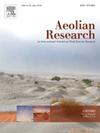Fluid-driven surface change in sediment-limited interdune environments and relevance to Titan
IF 3.4
3区 地球科学
Q2 GEOGRAPHY, PHYSICAL
引用次数: 0
Abstract
Interdune areas and purported playa-type environments in Saturn’s moon Titan’s dune fields show substantial spatial variability in radar backscatter expression. Using examples from Death Valley, the Middle East, and northern China, this work evaluates terrestrial causes of spatial backscatter heterogeneity in similar aeolian environments. It introduces the importance of temporal change detection in interdune area backscatter expression. Using optical images, time-series radar synthetic aperture radar images, and coordinated meteorological and river discharge data (where available), backscatter variations are related to spatially changing sedimentary environments within sediment-limited areas, i.e., interdune and playas, and temporally changing surface or near-surface moisture conditions. In terrestrial environments, backscatter expression varies over seasonal and annual timescales as a function of the cumulative history of surface change, primarily driven by changes in surface and near-surface moisture from either precipitation or groundwater table rise and fall. On Titan, evidence for equatorial methane flow channels suggests that arid-climate surfaces may undergo temporal evolutions like those observed on Earth. Fluid flow and evaporite formation play crucial roles in the existence and alteration of patterns in Earth’s interdunes. By analogy, these mechanisms are also expected to be at work on Titan. Despite differences between terrestrial and Titan radar observations, considering surface dynamics and evolution over time on Titan may be critical for analyzing its arid, equatorial environments.
沉积物限制沙丘间环境中流体驱动的地表变化及其与土卫六的相关性
在土星的卫星土卫六的沙丘场中,沙丘间区域和所谓的playa型环境在雷达后向散射表达中显示出实质性的空间变异性。以死亡谷、中东和中国北方为例,本研究评估了相似风沙环境下空间后向散射异质性的陆地原因。介绍了时间变化检测在沙丘间背向散射表达中的重要性。利用光学图像、时间序列雷达合成孔径雷达图像以及协调的气象和河流流量数据(如有),研究了后向散射变化与沉积受限区域(即沙丘间和playas)内沉积环境的空间变化以及地表或近地表湿度条件的时间变化有关。在陆地环境中,背向散射的表达随季节和年时间尺度的变化而变化,作为地表变化累积历史的函数,主要受降水或地下水位上升和下降引起的地表和近地表水分变化的驱动。在土卫六上,赤道甲烷流动通道的证据表明,干旱气候表面可能经历了像地球上观察到的那样的时间进化。流体流动和蒸发岩的形成对地球沙丘间格局的存在和变化起着至关重要的作用。以此类推,这些机制也有望在土卫六上发挥作用。尽管陆地和土卫六的雷达观测存在差异,但考虑土卫六上的表面动力学和随时间的演变可能对分析其干旱的赤道环境至关重要。
本文章由计算机程序翻译,如有差异,请以英文原文为准。
求助全文
约1分钟内获得全文
求助全文
来源期刊

Aeolian Research
GEOGRAPHY, PHYSICAL-
CiteScore
7.10
自引率
6.10%
发文量
43
审稿时长
>12 weeks
期刊介绍:
The scope of Aeolian Research includes the following topics:
• Fundamental Aeolian processes, including sand and dust entrainment, transport and deposition of sediment
• Modeling and field studies of Aeolian processes
• Instrumentation/measurement in the field and lab
• Practical applications including environmental impacts and erosion control
• Aeolian landforms, geomorphology and paleoenvironments
• Dust-atmosphere/cloud interactions.
 求助内容:
求助内容: 应助结果提醒方式:
应助结果提醒方式:


